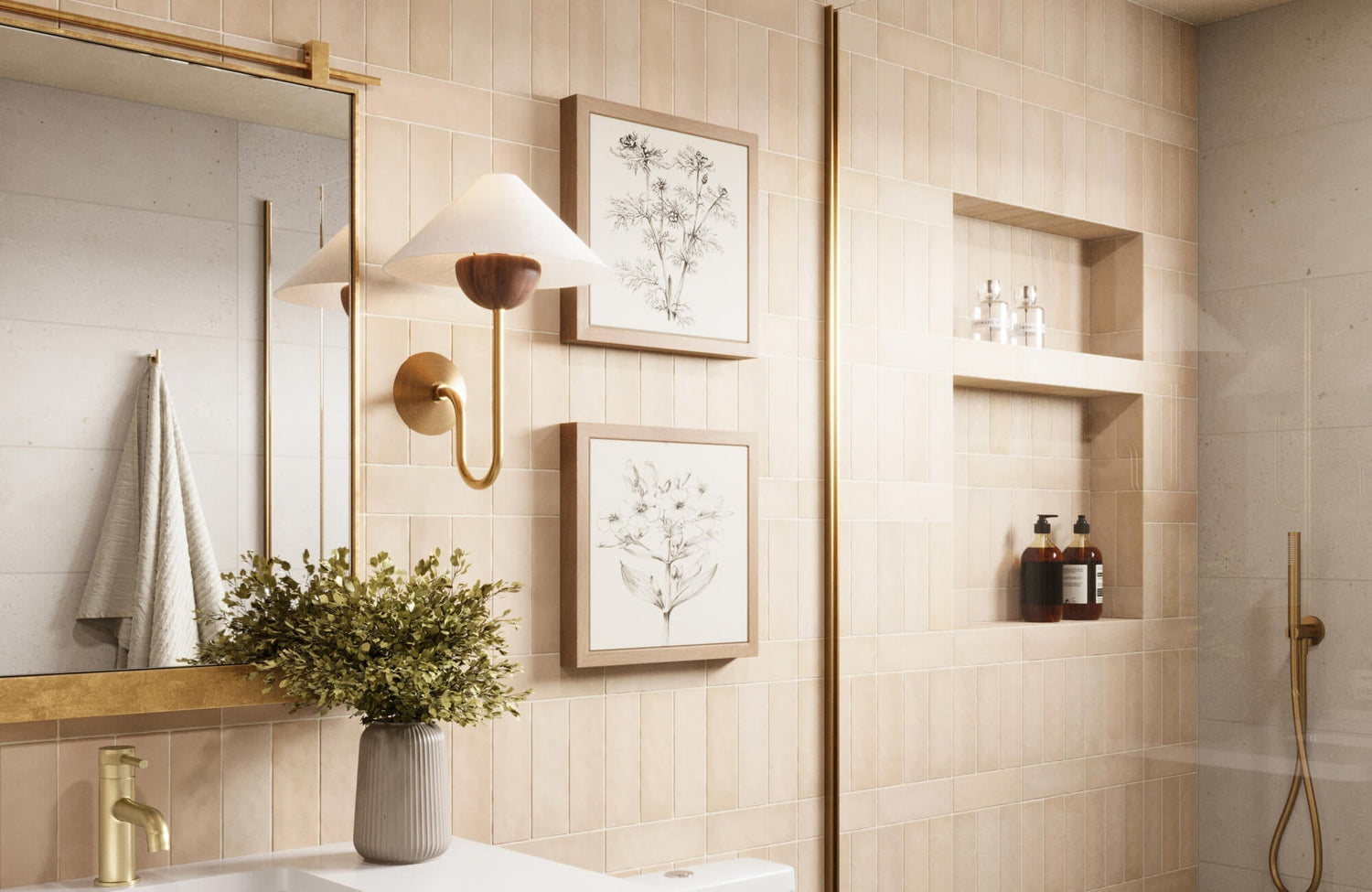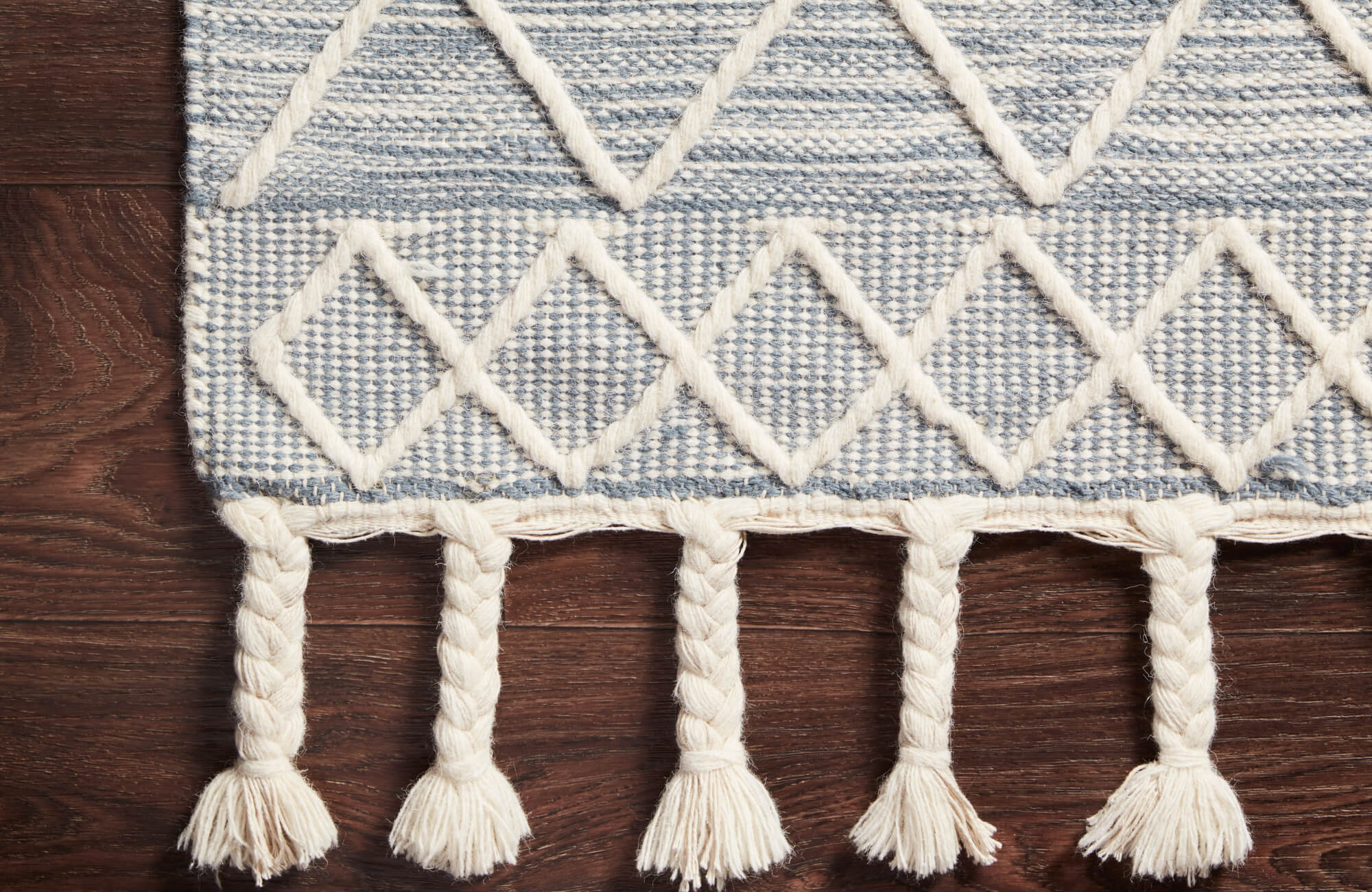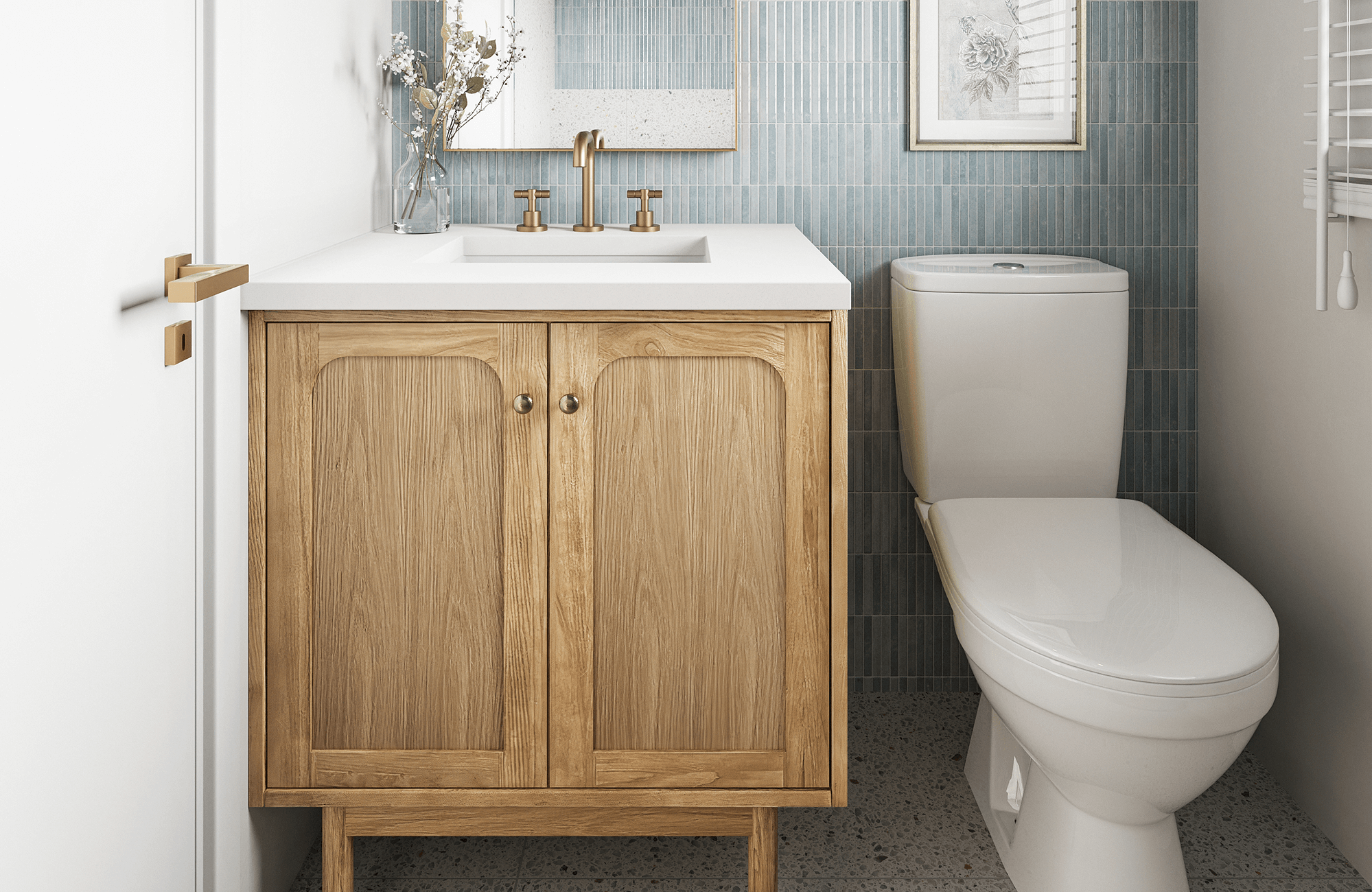Wall lights aren’t just there to light up a room, they help set the mood, guide the eye, and tie your whole space together. Whether it’s a cozy reading corner, a hallway that needs a little lift, or a bathroom that calls for clarity, the right wall light can make all the difference.
Still, choosing one isn’t always as simple as picking your favorite style. From size and placement to wall material and light temperature, there’s a bit more to think about. This guide breaks it down so you can pick a fixture that works well and feels just right in your space.

Define the Function of the Wall Light
Before picking a style or finish, it’s important to think about what the wall light actually needs to do. Is it meant to brighten up a hallway, add soft lighting beside your bed, or bring clarity to a bathroom mirror, like our Geraldine Wall Sconce in Aged Brass shown above? Defining the light’s function, whether it's task, ambient, or accent lighting, helps you narrow down your options and avoid choosing something that looks great but doesn't perform well. For example, a soft-glow sconce may feel cozy in a reading nook but won’t cut it in front of a vanity.
Also, how and where the light is used will affect how bright it needs to be and how high or low it should be mounted. A hallway might benefit from subtle uplighting to guide the way, while a bedside wall light needs focused light for reading without overwhelming the space. Thinking through function first makes it easier to choose the right bulb type, shade design, and overall layout, ensuring the light fits your lifestyle, not just your walls.
Consider the Size and Scale of the Fixture
Wall lights should feel proportionate to the space they occupy. When a fixture is too large, it can visually dominate the area; too small, and it might get lost entirely. For instance, a petite wall sconce might work well beside a bathroom mirror, but it could feel underwhelming on a tall, empty hallway wall. Matching the light’s size to the wall area and surrounding furniture helps everything feel cohesive.
The scale of a fixture also influences how it reads in a room. Oversized wall lights often create a bold, sculptural effect—ideal for modern, minimalist rooms that benefit from strong visual anchors. Compact fixtures, on the other hand, tend to disappear into busy walls or complement tighter layouts like small bedrooms or reading nooks. It’s all about how much presence you want the light to have.
Take cues from your room’s layout and ceiling height, too. A taller space can handle longer or stacked fixtures without throwing off balance, while lower ceilings pair better with streamlined designs. Thinking about size and scale early on makes it easier to choose a light that supports both the design and function of your space.
Match the Fixture to Your Design Style
Your wall light should feel like it belongs to the room, not just in function, but also in personality. For instance, a sleek, matte black sconce, like our Frances Wall Sconce in Black Brass, pairs well with modern spaces, while a brass fixture with pleated shades leans more traditional. The finish, shape, and even the bulb style all contribute to how well the light complements your existing décor. Choosing a fixture that reflects your interior style helps the space feel cohesive, even if the rest of the lighting is subtle.
Think about how the fixture interacts with other visual details in the room as well. If your space already includes brushed metal hardware or warm wood accents, look for lighting with similar finishes or tones. It’s not about matching everything perfectly—just maintaining a consistent visual rhythm so nothing feels out of place.
Don't forget to consider the mood your design aims to create. For example, soft fabric shades might add warmth to a cozy reading nook, while clear glass lends a more open, airy feel in a minimalist hallway. Matching your light’s look to your style isn’t just about trend-following—it’s about making the room feel intentional and well thought-out.

Different Types of Wall Lighting Fixtures
Wall-mounted lights come in more than just one style. From compact task lights to decorative sconces, each type serves a different purpose and adds a distinct personality to your space. Below, we’ll walk through the most common types to help you decide which one makes the most sense for your room.
Sconces
Sconces, such as our Winifred Wall Sconce in Aged Brass above, are one of the most flexible types of wall lighting, suitable for hallways, living rooms, bathrooms, and even entryways. They can be mounted facing up, down, or sideways, depending on the light direction you need. For instance, uplighting sconces offer a soft ambient glow, while downlighting works well for task areas like vanities. They also come in a wide range of styles, from minimal and modern to ornate and traditional.
Picture Lights
Picture lights are designed to highlight artwork or wall décor, giving your favorite pieces the attention they deserve. These fixtures mount just above or beside the frame and provide focused, narrow beams that prevent glare while enhancing detail. They work especially well in galleries or formal living rooms, but they can be used in casual spaces too. If you have a wall feature you'd like to spotlight, this type adds a subtle, refined glow.
Swing Arm Lights
Swing arm lights are a great solution when you need light exactly where you want it. Their adjustable arms make them ideal for reading nooks, desks, or bedside setups, where flexibility is key. They’re often found in more functional areas, but with the right finish and shade, they can easily blend into stylish interiors as well. Also, since they mount directly to the wall, they help free up valuable surface space.
Flush Mount Wall Lights
Flush mount wall lights sit directly against the wall without extending too far outward, making them perfect for narrow or busy areas. For example, staircases or hallway corridors often benefit from this style since it doesn’t intrude into the space. The clean profile also works well in contemporary or minimalist rooms that favor sleek lines and subtle detailing. Despite their compact build, they can still provide surprisingly effective ambient lighting.
Candle-Style Wall Lights
Candle-style wall lights add character to traditional and transitional interiors alike. With silhouettes inspired by classic candle holders, they bring a warm, timeless atmosphere to dining rooms, hallways, or even bathrooms. You’ll often find these in pairs, flanking mirrors or entryways for a more balanced look. They also work well when you want a decorative touch that doubles as soft, mood-setting light.
Recessed or Architectural Wall Lighting
Recessed wall lights, sometimes called niche or architectural lights, are built into the wall itself to create a seamless, modern look. They’re often used for accent lighting along staircases, hallways, or gallery walls, places where you want light without seeing a fixture. Also, since the bulb and housing are hidden, they offer a clean, clutter-free appearance that works beautifully in contemporary interiors. These are ideal for those who prefer an understated lighting solution with strong visual impact.
Know Your Wall Type Before You Install
Not all walls are created equal, and knowing what you’re working with can save time, damage, and frustration. The material behind your paint or tile will determine what tools, anchors, and techniques you need to mount your wall light safely and securely. Below, we’ll cover the most common wall types and what to keep in mind for each one.
Drywall
Drywall is the most common interior wall surface and one of the easiest to work with when installing light fixtures. You’ll typically only need plastic anchors or toggle bolts to hold up most wall lights, especially if no stud is available behind the surface. It's lightweight but not load-bearing, so avoid heavy fixtures without proper support. A mounting plate and level help ensure a clean, stable finish.
Plaster
Older homes often use plaster, which is denser and more brittle than drywall. Drilling into plaster requires a slow, steady hand to avoid cracks, and it’s best to use masking tape over the drill spot to help protect the surface. Plastic anchors may not hold well, so aim for wall studs or use toggle bolts rated for masonry. If the wall feels hollow behind the plaster, a stud finder may help pinpoint safe zones.
Tiled Walls
Tiled walls, common in bathrooms and kitchens, need more precision to avoid damaging the surface. Use a diamond-tipped drill bit, go slowly, and apply masking tape over the tile to help prevent slips or chips. It's best to drill into the grout lines when possible, as it's softer than tile. Always double-check the backing material behind the tile, whether drywall or cement board, before choosing your anchors.
Concrete or Brick
Installing into concrete or brick requires more effort and the right heavy-duty tools. A hammer drill and masonry bit are essential, and you'll need robust wall anchors or masonry screws to secure your fixture properly. These surfaces provide excellent stability once installed, but don’t allow for mistakes, so careful measurements are key. Also, be prepared for a bit of dust—lay down a drop cloth and wear eye protection while drilling.
Factor in Installation and Maintenance Needs
When selecting a wall light, it’s worth considering how the fixture will be installed and cared for over time. Hardwired options deliver a seamless, built-in look but usually require access to an electrical junction box and might call for professional help. Plug-in models, by contrast, are ideal for renters or those seeking a quick upgrade—they’re easy to mount and don’t involve permanent changes. Deciding which setup suits your space helps simplify the entire process from the start.
Maintenance should factor into your decision, too. Fixtures installed high up or tucked into corners can be tricky to reach for bulb changes or routine dusting. In spaces like vanities or hallways where lights get more frequent use, go for designs that offer easy access to bulbs and shades. A bit of foresight here can keep your setup both practical and polished.
Placement is equally important to how the light performs. Wall sconces typically work best when mounted around 60 to 66 inches from the floor, or roughly at eye level, though you can tweak this depending on your ceiling height or furniture. Consistent spacing and thoughtful positioning help avoid glare and awkward shadows while making the whole room feel more balanced.
Think About Light Temperature and Brightness
Light does more than illuminate, it sets the tone for how a room feels and functions. The warmth or coolness of the light, along with its brightness level, can shape everything from your mood to how well you focus. In this section, we’ll walk through how to choose lighting that works with your space, not against it.
Warm vs. Cool Light Tones
Warm light creates a welcoming, cozy feel, making it well-suited for bedrooms, living rooms, and dining spaces. Cooler light offers a sharper, cleaner tone that’s better for focus, which is why it works well in bathrooms, home offices, and task-driven areas. The goal is to match the tone to how the room is used on a daily basis. This small choice can have a big impact on comfort and functionality.
Brightness and Lumens
Brightness is just as important as tone when it comes to how useful the light will be. For relaxed areas, lower lumen counts help create a softer ambiance without glare or eye strain. For task-oriented zones, like vanities or reading corners, opt for brighter bulbs around 800 lumens or higher for better visibility. Still, it’s not about going as bright as possible, but about finding the right level for the activity at hand.
Matching Light to Room Function
Every space has a purpose, and your lighting should reflect that. For instance, bedrooms often feel best with warm, adjustable lighting that supports winding down, while workspaces or hallways benefit from consistent, cooler lighting that promotes clarity. Kitchens sit somewhere in the middle, depending on whether you’re entertaining or prepping meals. When light is chosen with intention, it complements the flow and mood of your space beautifully.
Finding the Best Fit for Your Space and Style
Choosing the right wall light isn’t just about picking a style you like, it’s about understanding how it fits your space, your lifestyle, and your existing design. From determining function and scale to matching finishes and thinking through installation, each detail plays a part in how your space looks and feels. With the right fixture, even a simple sconce can bring both beauty and balance to a room.
If you're still unsure where to begin, our design team is here to help. Whether you're upgrading a hallway, planning a full room refresh, or coordinating multiple fixtures across your home, Edward Martin’s professional design services can guide you through every step. Let us help you choose lighting that works beautifully and works for you.












